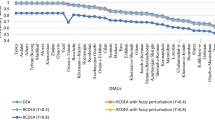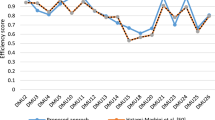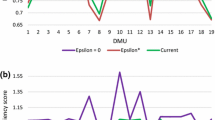Abstract
Incorporating decision makers’ (DMs’) judgments and preferences into DEA models is very important in some real-world problems. This paper presents an integrated data envelopment analysis (DEA)—best–worst method (BWM)—for considering DMs’ preferences in DEA and reducing flexibility in weights of inputs and outputs. First, the preferences vectors are designed using BWM, and then, a multi-objective DEA-BWM model is introduced. The proposed DEA-BWM model simultaneously maximizes the efficiency scores of DMUs and considers DMs’ preferences about weights of inputs and outputs. Finally, a goal programming model is suggested for extending the DEA-BWM model and finding common weights of inputs and outputs based on the DMs’ judgments. The proposed common weight DEA-BWM (CWDEA-BWM) model maximizes the efficiencies of DMUs, considers DMs’ preferences and uses a set of common weights. In order to illustrate the capability of proposed models, a numerical example is solved. Moreover, the proposed DEA-BWM and common weight DEA-BWM models are applied to evaluate 39 Iranian electricity distribution companies, and the results are analyzed and compared. The results indicate that the proposed DEA-BWM and CWDEA-BWM models are suitable for incorporating DMs’ preferences into DEA and fully ranking of DMUs.

Similar content being viewed by others
References
Allen R, Athanassopoulos A, Dyson RG, Thanassoulis E (1997) Weights restrictions and value judgments in data envelopment analysis: evolution, development and future directions. Ann Oper Res 73:13–34
Avkiran NK (2006) Productivity analysis in the service sector with data envelopment analysis. SSRN: https://ssrn.com/abstract=2627576 or http://dx.doi.org/10.2139/ssrn.2627576
Azadeh A, Ghaderi SF, Omrani H (2009) A deterministic approach for performance assessment and optimization of power distribution units in Iran. Energy Policy 37(1):274–280
Çelen A (2013) Efficiency and productivity (TFP) of the Turkish electricity distribution companies: an application of two-stage (DEA&Tobit) analysis. Energy Policy 63:300–310
Charnes A, Cooper WW, Rhodes E (1978) Measuring the efficiency of decision making units. Eur J Oper Res 2(6):429–444
Charnes A, Cooper WW, Huang ZM (1990) Polyhedral cone-ratio DEA models with an illustrative application to large commercial banks. J Econom 46(1–2):73–91
Dyson RG, Thanassoulis E (1988) Reducing weight flexibility in data envelopment analysis. J Oper Res Soc 39(6):563–576
Golany B (1988) Note—a note on including ordinal relations among multipliers in data envelopment analysis. Manage Sci 34(8):1029–1033
Goto M, Tsutsui M (1998) Comparison of productive and cost efficiencies among Japanese and US electric utilities. Omega 26(2):177–194
Hatami-Marbini A, Tavana M, Agrell PJ, Lotfi FH, Beigi ZG (2015) A common-weights DEA model for centralized resource reduction and target setting. Comput Ind Eng 79:195–203
Hjalmarsson L, Veiderpass A (1992) Productivity in Swedish electricity retail distribution. Scand J Econ 94:193–205
Jain V, Kumar A, Kumar S, Chandra C (2015) Weight restrictions in data envelopment analysis: A comprehensive genetic algorithm based approach for incorporating value judgments. Expert Syst Appl 42(3):1503–1512
Jamasb T, Pollitt M (2003) International benchmarking and regulation: an application to European electricity distribution utilities. Energy Policy 31(15):1609–1622
Kao C, Hung HT (2005) Data envelopment analysis with common weights: the compromise solution approach. J Oper Res Soc 56(10):1196–1203
Khalili M, Camanho AS, Portela MCAS, Alirezaee MR (2010) The measurement of relative efficiency using data envelopment analysis with assurance regions that link inputs and outputs. Eur J Oper Res 203(3):761–770
Kritikos MN (2017) A full ranking methodology in data envelopment analysis based on a set of dummy decision making units. Expert Syst Appl 77:211–225
Lai PL, Potter A, Beynon M, Beresford A (2015) Evaluating the efficiency performance of airports using an integrated AHP/DEA-AR technique. Transp Policy 42:75–85
Liu ST (2014) Restricting weight flexibility in fuzzy two-stage DEA. Comput Ind Eng 74:149–160
Mi X, Tang M, Liao H, Shen W, Lev B (2019) The state-of-the-art survey on integrations and applications of the best worst method in decision making: why, what, what for and what’s next? Omega. https://doi.org/10.1016/j.omega.2019.01.009
Omrani H (2013) Common weights data envelopment analysis with uncertain data: a robust optimization approach. Comput Ind Eng 66(4):1163–1170
Omrani H, Alizadeh A, Amini M (2019) A new approach based on BWM and MULTIMOORA methods for calculating semi-human development index: an application for provinces of Iran. Socio-Econ Plan Sci. In press. https://doi.org/10.1016/j.seps.2019.02.004
Pakkar MS (2015) An integrated approach based on DEA and AHP. CMS 12(1):153–169
Podinovski VV (2004) Production trade-offs and weight restrictions in data envelopment analysis. J Oper Res Soc 55(12):1311–1322
Podinovski VV, Athanassopoulos AD (1998) Assessing the relative efficiency of decision making units using DEA models with weight restrictions. J Oper Res Soc 49(5):500–508
Rezaei J (2015) Best-worst multi-criteria decision-making method. Omega 53:49–57
Rezaei J (2016) Best-worst multi-criteria decision-making method: some properties and a linear model. Omega 64:126–130
Rezaei J, Kothadiya O, Tavasszy L, Kroesen M (2018) Quality assessment of airline baggage handling systems using SERVQUAL and BWM. Tour Manag 66:85–93
Roll Y, Cook WD, Golany B (1991) Controlling factor weights in data envelopment analysis. IIE Trans 23(1):2–9
Sadjadi SJ, Omrani H (2008) Data envelopment analysis with uncertain data: an application for Iranian electricity distribution companies. Energy Policy 36(11):4247–4254
Salimi N, Rezaei J (2016) Measuring efficiency of university-industry Ph.D. projects using best worst method. Scientometrics 109(3):1911–1938
Salimi N, Rezaei J (2018) Evaluating firms’ R&D performance using best worst method. Eval Prog Plan 66:147–155
Thanassoulis E, Portela MC, Allen R (2004) Incorporating value judgments in DEA. Handbook on data envelopment analysis. Springer, New York, pp 99–138
Thompson RG, Singleton FD Jr, Thrall RM, Smith BA (1986) Comparative site evaluations for locating a high-energy physics lab in Texas. Interfaces 16(6):35–49
Wang YM, Chin KS, Poon GKK (2008) A data envelopment analysis method with assurance region for weight generation in the analytic hierarchy process. Decis Support Syst 45(4):913–921
Wong YH, Beasley JE (1990) Restricting weight flexibility in data envelopment analysis. J Oper Res Soc 41(9):829–835
Zhang Y, Bartels R (1998) The effect of sample size on the mean efficiency in DEA with an application to electricity distribution in Australia, Sweden and New Zealand. J Prod Anal 9(3):187–204
Zohrehbandian M, Makui A, Alinezhad A (2010) A compromise solution approach for finding common weights in DEA: an improvement to Kao and Hung’s approach. J Oper Res Soc 61(4):604–610
Acknowledgements
The authors would like to thank Professor Antonio Di Nola, The Editor-in-Chief of journal of Soft Computing, and the anonymous reviewers for their insightful comments and suggestions. As a result, this paper has been improved substantially.
Author information
Authors and Affiliations
Corresponding author
Ethics declarations
Conflict of interest
The authors declare that they have no conflict of interest.
Ethical approval
This article does not contain any studies with human participants or animals performed by any of the authors.
Additional information
Communicated by V. Loia.
Publisher's Note
Springer Nature remains neutral with regard to jurisdictional claims in published maps and institutional affiliations.
Rights and permissions
About this article
Cite this article
Omrani, H., Alizadeh, A. & Naghizadeh, F. Incorporating decision makers’ preferences into DEA and common weight DEA models based on the best–worst method (BWM). Soft Comput 24, 3989–4002 (2020). https://doi.org/10.1007/s00500-019-04168-z
Published:
Issue Date:
DOI: https://doi.org/10.1007/s00500-019-04168-z




